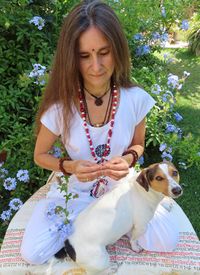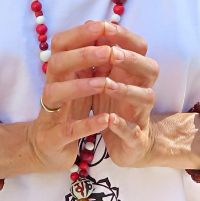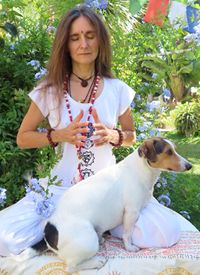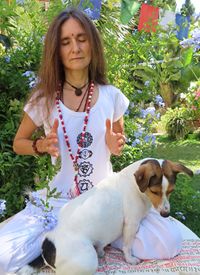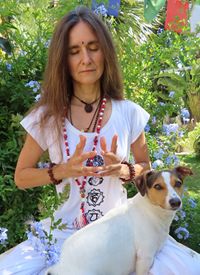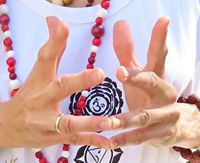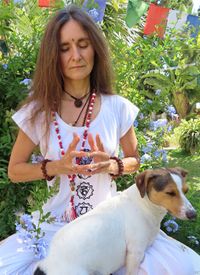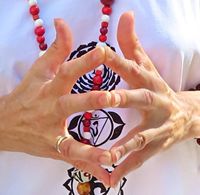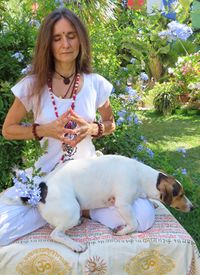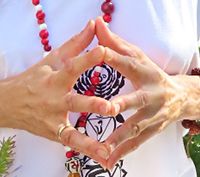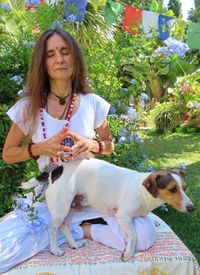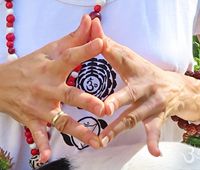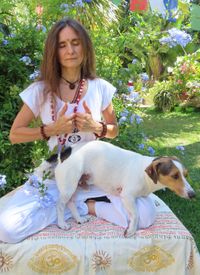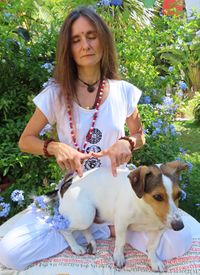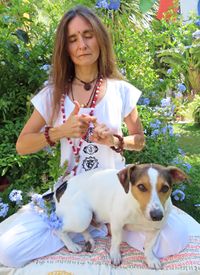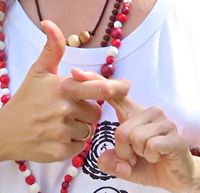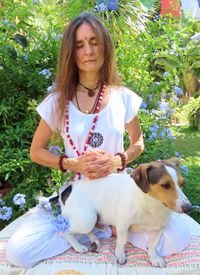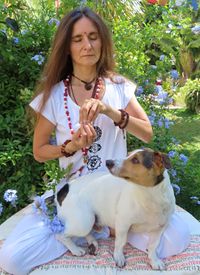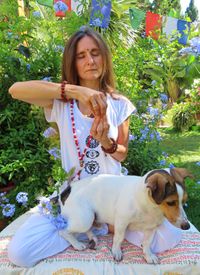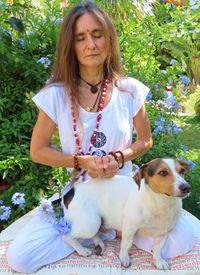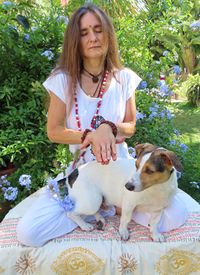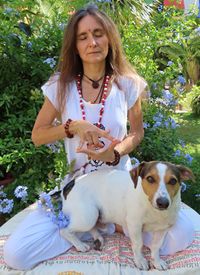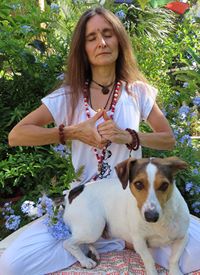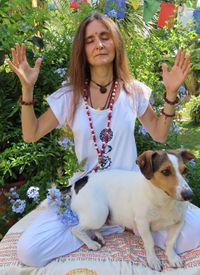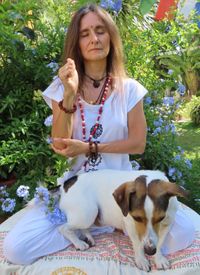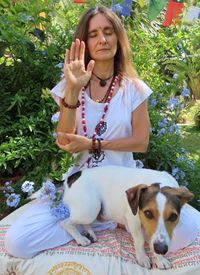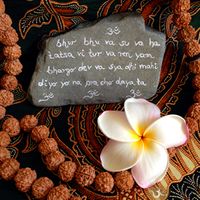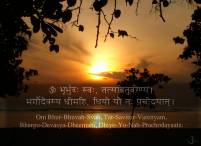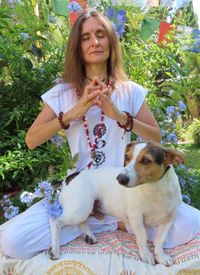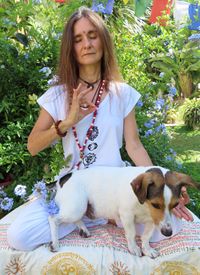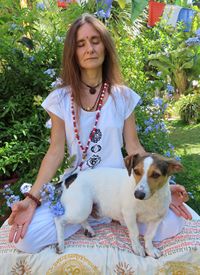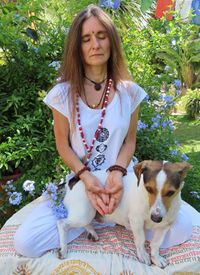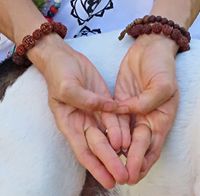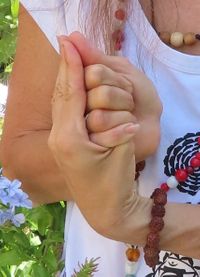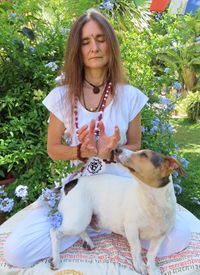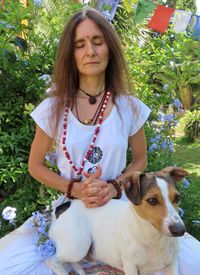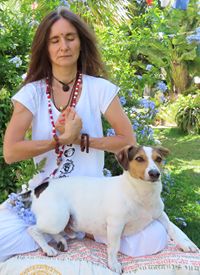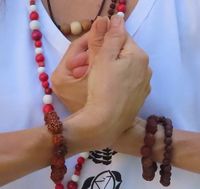ॐ भूर्भुवः स्वः ।तत्सवितुर्वरेण्यं ।भर्गो देवस्य धीमहि ।धियो यो नः प्रचोदयात्
oṃ bhūr bhuvaḥ svaḥá savitúr váreṇiyaṃ bhárgo devásya dhīmahi dhíyo yó naḥ pracodáyath
Gayatri Mudras
The Gayatri-Mudra cycle is a wonderful sadhana (spiritual practice) that I don't want to miss. I've been doing it for many years. I had originally learned it as a healing practice. But later I found out that it is part of the daily sadhana of Brahmin priests, also on my beloved island of Bali. They are part of the "Sandhyavandanam" practice that I have described to you on the Gayatri mantra page - in a simple form, as I do it myself every day, because it traditionally lasts more than 2 hours (x3 times a day). That would be impossible in my everyday life. I have learned that the Gayatri Mudras allow the life giving power to circulate in the body. This force is called Prana in Ayurveda or Yoga. The Gayatri Mudras start a healing process. By reciting the luminous OM and the Gayatri mantra itself, my body is revived. A nice word, because it means so much that even dead cells are brought back to life. Even if this is perhaps not scientifically proven, I really feel a lot of light when I turn to this sadhana full of love and I want to share it with you.
Actually I wanted to write about the healing effects of each mudra, but I decided against it. The spiritual meaning is auspicious enough ... you will see and feel it!
I have crooked fingers, some with injured tendons, but despite this or because of this, mudras are part of my everyday life. I am certainly not the perfect person. But I would like to encourage all of you to show what is important to you, to your heart and soul anyway. No matter what you look like, whether you can do it absolutely perfect or not.
Traditionally the Gayatri mudras with reciting the Gayatri mantra (Japa) should be performed with a calm heart, controlled mind and great confidence. The Gayatri mudras should not be done casually, but really very consciously with devotion, otherwise they have no effect, just as the Gayatri mantra should not have the original effect if you simply chant it without the mudras. The mudras should also be held a little longer (at least as long as you can let a syllable of Gayatri vibrate within you). You should also live a yogic life. These are all commandments now, but that does not mean that these sadhanas are not full of love, joy and bliss! Enjoy the mantras with Mowgli and me!
These are 24 Gayatri Mudras to be performed before Gayatri Japa:
(if you click on the photos, you can see the finger position exactly)
Sumukham Mudra
This mudra is the beginning of a creation process. It is the first of the 24 Gayatri Mudras hence it prepares the body and mind towards meditation. With the practice of this mudra, there is a slow opening of the channels (nadis) for the free flow of prana that helps to clear the blockages, preparing the body for sitting in meditation. When the body is ready, the mind too can be channelized towards the path of meditation. In this hand gesture, the tips of all the fingers are placed touching each other respectively, with the focus on bringing connection to all the elements (earth, water, air, fire, ether) in the body and chakras. In this mudra lies the energy of absolute volition.
When you practice this mudra, sing the first “Vyahriti” – BHUR
and visualize this: “Dwelling in the self, I am a seed”
Samputam Mudra
Traditionally, the Samputam Mudra is now used in the Gayatri mudra cycle. Samputam means “ bud of a flower”. I learned the mudra a little differently than you can see it on photos on the Internet. It looks more than a slight variation of the Anjali or Namaskar Mudra. The fingertips of the index, middle, ring and little finger touch the one on the other side. Put your thumbs together side by side. The mudra looks like a fresh bud that is about to open. Symbolically it is meant that you are ready to bloom. It helps to awaken the inherent peace within each of us. The scent is only hidden in the bud. In this mudra lies the energy of absolute knowledge (jnana).
When you practice this mudra, sing the first syllable of the second “Vyahriti” – BHU
and visualize this: “Pulled towards the world”.
Vittam Mudra
It is the gesture of viral energy - with this mudra the energy body is attuned to the free flow of life energy. It prepares you to move gently and evenly in the rhythm of Gayatri. At the same time, it has a healing effect on your reproductive and urinary tract as well as your lower back, but you would have to have been practicing the mudra for a long time. Vittam means "partially open bud". So hold your hands as if you were protecting this delicate bud. (see photo)
When you practice this mudra, sing the second syllable of the second “Vyahriti”- VAH
and visualize this: “I separate from thee” (from the state of a closed bud)
Visttam Mudra
It is a gesture that you use to expand yourself further and further. Coming out of the Vittam mudra, you now open your hands, which are held parallel to each other, and thus release yourself somewhat from the protective position for the bud. I like to do the mudra in the spiritual heart area because for me it means opening the heart.
When you practice this mudra, sing the first syllable of the third “Vyahriti”- SU
and visualize this: “expanding”
The next four mudras belong together in visualization:
“I experience the various aspects of life (through five senses).”
Dvi Mukham Mudra
It is the gesture that makes me aware of duality in nature.
Purusha – Prakrithi. Purusha is the soul, the Self, pure consciousness,
and the only source of consciousness.
Prakrithi is that which is created.
Dvi Mukham means also the power of Gayatri in FIRE nature.
When you practice this mudra, sing the second syllable of the third “Vyahriti”- VA
Tri Mukham Mudra
It is the gesture that sets all three aspects of divine energy in motion.
This mudra contains the nature of Brahma the Creator, Vishnu the Preserver, and Maheshwara (Shiva) the Transformer.
It also represents the tree energies of life:
Iccha Shakti, desire; Jnana Shakti, that is, action, effort; and Kriya Shakti, knowledge.
When you practice this mudra, sing the second syllable of the third “Vyahriti”- HA
Chatur Mukham Mudra
It is the gesture which contains four energies. “Chatur” means four and “mukham” face. "Chatur Mukti" is a popular representation of the four faces / aspects of Brahman.
1.The nature of Brahman: Everything came into being through Brahman's infinite greatness, beauty, bliss and love for life. And everything is a manifestation of his overflowing abundance.
2.Brahman in the source: Brahman does not create out of nothing, but out of the reality of his own being. Brahman is both the material as well as the efficient cause of creation.
3.The final goal: Brahman is the formal cause and the goal of all reality, that is, the ultimate cause. Brahman is the only substantial real that really exists. Everything else is either transformations of Brahman or beings of an illusory nature.
4.Brahman is the Ultimate Reality: All reality has its source in Brahman. All reality has its grounding sustenance in Brahman. It is in Brahman that all reality has its ultimate repose.
So the mudra represents the Gayatris energy in the four aspects of Brahman, but "Chatur Mukta" also stands for the four Vedas.
Remember, the Gayatri is the essence of all Vedas! And the term also stands for the four "human goals" (Purusharthas), Kama (sense gratification), Artha (prosperity), Dharma (fulfillment of duty), Moksha (liberation).
When you practice this mudra, sing the syllable TATSA .
Panch Mukham Mudra
It is the gesture which contains five (panch) energies of Bhutas in nature.
Bhutas are "supernatural beings/disembodied spirits" (many of which work invisibly around us)
but also the cosmic elements (earth, water, air, fire, ether)
and each finger activates one of these elements.
When you practice this mudra, sing the syllable VI .
Shan Mukham Mudra
Shanmukha means that God looks in all directions and that you see God in all directions.
Six faces are the four cardinal points as well as above and below.
You see the divine around you, you see it in the past and the future.
The divine can be experienced everywhere,
even in this moment when you practice this mudra.
When you practice this mudra, sing the syllable TUR
and visualize this: “I withdraw my mind” (if the divine is everywhere, then it is in me too).
Adho Mukham Mudra
It is the gesture with which you can clear your mind and really prepare yourself for meditation.
An obstacle for meditation is the excessive thought processes happening in the mind.
Adhomukham means downward, so you let all your thoughts flow away.
When you practice this mudra, sing the syllable VA
and visualize this: “from the flow of the world”
Vyaapakanjali Mudra
It is a cleansing gesture.
It causes a deep absorption and elaboration of the true reality of nature.
You also expand your horizons with it. It is also the “offering”-mudra.
When you practice this mudra, sing the syllable REN
and visualize this: “and offer my life to thee”
Shakatam Mudra
It is the gesture with which you set the structure of your energy body in motion.
You activate the chakras (1. Root Chakra (Muladhara), 2. Sacral Chakra (Swadhisthana), 3. Solar Plexus Chakra (Manipura), 4. Heart Chakra (Anahata), 5. Throat Chakra (Vishuddha), 6. Third-Eye Chakra (Ajna) and 7. Crown Chakra (Sahasrara). If you want, you can hold this mudra briefly on each chakra.
When you practice this mudra, sing the syllable YAM
and visualize this: “so you will flow thru me”
Yampasham Mudra
It is the gesture of mental clarity. With your thumb you align yourself upwards, with the other fingers you assume an attitude of reverence and humility. With this mudra you can completely bring you in a moment of death. A "little death” to experience rebirth. And be it just an awakening, a “little death” to start again. Yamapaasam means chain of death. If you want, you can hold this mudra briefly on each chakra. The syllable that you chant for this mudra is "bhargo", that means something like the light that drives the darkness out of your life. The "little death” can give you this light.
When you practice this mudra, sing the syllable BHARGO
and visualize this: “revealing the reality of birth and death”
Granthitam Mudra
It is a very important gesture in the Gayatri mudra cycle.
The mudra is reminiscent of a knot, of being entangled in something that is not true reality.
Open this knot and you will detach yourself from Maya, the worldly, the emotions, the temptations. You turn to the divine (DEV)
When you practice this mudra, sing the syllable DEV
and visualize this: „ and bondage of maya”
Chormukhookham Mudra
It is a mudra that consists of two parts, as you can see in the photos.
With these gestures you enter into a deep relationship with the divine (Paramaatma).
In principle, all mudras are previously a practice to empty yourself, i.e. to make space for the divine.
I understand these mudras as follows:
Because they are practiced once this way and once the other way around,
it means as much as: God is in me and I am in God.
When you practice this mudra, sing the syllable SYA (be on the move)
and visualize this: “ empty myself, to be filled by thee”
Prlambam Mudra
It is the gesture of "growing up", of liberation from the worldly, from the dependence on Maya. Moksha, breaking out of the cycle of rebirths (samsara).
When you practice this mudra, sing the syllable DHI (deep understanding)
and visualize this: “I relinquish the world”
Mustikam Mudra
It is the gesture of dissolving Ajñāna. Ajñāna refers to our perceptions of ourselves. We think of ourselves also as being abiding, important, substantial and permanent. We create, project, abide in and become deeply attached to our multiple personalities which form our concept of “self”.
Now when you practice this Mutra, always focus on your goal on the Supreme Soul by letting go of Ajñāna, and sing the syllable MAHI. "Mahi" means something like the union of heaven and earth, divine being.
Visualize: “and take refuge in thee”
Matsayam Mudra
It is a gesture with which you can, for example, purify water (holy). But it is also a mudra with which you can protect something from negative influences. Matsya in Sanskrit means “Fish”. Matsya Mudra also represents the “Matsya Avataram” of Lord Vishnu or a fish who fearlessly wades along in the “Samsara Segara” (ocean of samsara). In another story, Matsyendranath is associated with Shiva, the Adiyogi. A fish, but in reality he was actually a very great master who came from the previous life and had almost reached God-realization and he has come in this life to be a witness when Shiva teaches Hatha Yoga to the Parvati. She gave this fish a human body, she blessed him and commissioned him to bring Hatha Yoga into the world.
When you practice this mudra, sing the syllable DHIYO (intellect) with other words: With the presence of the divine in your mind, you can gain wisdom and the intellect to rise above materialistic desires.
Visualize this: “your guide the way giving”
Kurmam Mudra
Kurma means turtle, a prehistoric animal that has survived to this day. It stands for steadfastness. Another meaning: The turtle withdraws into its shell both for safety and restoration, and Kurma mudra produces a similar effect by naturally drawing the senses inward. In Asia, Kurma also applies to our mother earth, which enables us to live.
When you practice this mudra, sing the syllable YO
Visualize this: “strength”
Varaham Mudra
This mudra gives centering and calmness. It is also a gesture of wisdom.
Varaha means the day of happiness, which is a positive turning point in your life that will help you outgrow materialism and yearn for spiritual awakening. .
When you practice this mudra, sing the syllable NA
Visualize this: “and support”
The following four mudras belong together in their meaning:
(The individual syllables together form the "PRACHODAYATH" and that means as much as blessed, inspired, honored and enlightened by the divine)
Simhakranthi Mudra
Simha is one of the avatars of Vishnu.
When the devotee thinks of him with devotion, he destroys sin and anger.
I understand mudra to mean that I am ready to let go of those loud voices within myself to hear the soft voice of the divine.
When you practice this mudra, sing the syllable PRA
Visualize this: „I shut out the noise of the world”
Mahakrant Mudra
It is another gesture to dissolve Ajnana ”non-knowledge”, to gain jnana, consciousness.
When I have now created this empty space, it fills with the light and voice of the divine.
When you practice this mudra, sing the syllable CHO
Visualize this: “so that I may here your voice”
Mudgara Mudra
This mudra can be used to instill courage and virtue.
With this gesture, you can also give yourself the impetus for the feeling of resolve and determination. It is like a weapon.
When you practice this mudra, sing the syllable DAYA
Visualize this: “you protect me and dispel my fears”
Palavam Mudra
It is a gesture with which you receive the blessings.
The Divine Power will flow through you and purify everything in you.
It's like recreating your own universe.
When you practice this mudra, sing the syllable TA
Visualize this: “illusion falls away”
Did you notice something?
When you look at the words from the visualization,
they together form the internal statement of the Gayatri mantra.
It helps you in practicing the presence of God, purifying yourself from illusions of Maya:
“dwelling in the self, I am a seed
pulled towards the worl
I separate from thee
expanding
I experience the various aspects of life (thru five senses)
I withdraw my mind
from the flow of the world
and offer my life to thee
so you will flow thru me
revealing the reality of birth and death
and bondage of Maya
empty myself, to be filled by thee
I relinquish the world
and take refuge in thee
your guide the way giving
strength
and support
I shut out the noise of the world
so that I may here your voice
you protect me and dispell my fears
illusion falls away”
Now you are truly ready to recite the Gayatri mantra!
Do it 27 times (1/4 mala), 54 times (1/2 mala), one cycle (108 times) or even more.
sunrise on Bali Island
When you have finished reciting, there are traditionally eight more mudras that are performed in silence. I recommend that you hold these mudras a little longer than the first twenty-four. If you have the time, feel it for between five and ten minutes. But of course you can also end it in one flow. The last eight mudras help you to go into yourself again and let the vibrating energy of the Gayatri mantra work.
The eight final mudras
Surabhi Mudra
It is a sacred and powerful gesture, and I have to tell you: It is one of my favorite mudras!
This gesture also has a story: Surabhi is the daughter of the divine cow Kamadhenu.
The placement of the fingers in this mudra symbolizes the udder of a cow.
The Surabhi Mudra is also known as the "wish-fulfilling gesture".
But in the sense of Gayatri, where we have just freed ourselves from all desires and the world, I would not practice it under this aspect.
Instead, concentrate on your Manipura Chakra (solar plexus).
It helps to balance all five elements.
The cow is one of the most revered animals in India, related to the earth and a symbol of maternal love and spiritual happiness!
The mudra embodies the aura of Kamadhenu, the sacred cow. It helps you to heal your spirit and gives you strength for the spiritual path.
Gyan Mudra
This mudra symbolizes the union of Self with the universe,
the unification of one's soul and the supreme Soul.
The thumb symbolizes the supreme Soul, the index finger refers to the practitioner's soul.
When I go into the Gyan with my fingers after the Gayatri Mantra, I feel a sense of lightness.
It's almost like a float. Gyan means wisdom.
Gyan Vairagya Mudra
It is a gesture, that develops the sense of detachment (Vairagya) within the body.
As this mudra takes you to a state of non-attachment from worldly limitations.
It is an important practice in the spiritual path.
This mudra influences spiritual powers within you and enhances self-awareness.
You can also practice this mudra while reciting the Gayatri mantra. If not with both hands, then at least with one hand. Instead of counting with a mala, you can also set a time. See how long you need for a cycle and the next time you set a clock for it. So you can sit calmly in the mudra, recite and feel the special vibrations of Gayatri. You will feel a great devotion.
Sarva-Yoni Mudra
this mudra is a powerful exercise for calming the mind.
You lead the energy of the fifth senses (symbolic for the five fingers of a hand) back to the source of your being. Yoni is the womb and with the help of this mudra you can return to this magical space.
In the womb we once felt secure, not yet touched by the outside world, pure, innocent.
A wonderful mudra. I love it very much.
Shankh Mudra
It is a sacred gesture often used by the priest in Hindu purification ceremonies.
Shankh means sea shell and is the symbol for the ritual conch shell that is blown in the temples in the morning. The mudra removes impurities of all kinds in you so that a divine ray of light can illuminate your own inner temple.
The mudra also symbolizes the cosmic primordial sound, so you can also let the OM vibrate internally. If you can feel it better by singing out loud, then chant it.
Pankaj Mudra
it is a gesture that is supposed to represent an open lotus flower. Lotus flowers have so many meanings in Asia. On the one hand, it grows out of the mud and yet it is such a wonderful flower.
It is like a journey from the darkness to the light. On the other hand, every drop of water rolls off it. She lives in the world and yet she cannot be touched by it. Just like we should live as spiritual seekers. The lotus flower symbolizes purity and devotion, a fully bloomed lotus represents our enlightened and awakened self.
Shiva Linga Mudra
It is a powerful hand gesture that represents both Shiva and the goddess Parvathi, a symbol of masculinity and femininity. The mudra symbolizes the integration of the energies of Shiva and Shakti. Shiva is represented by the thumb pointing upwards, the rest of the mudra is Shakti. The masculine, fiery energy rests on the feminine energy. The thumb up ultimately a symbol for the aspiration up to the infinite. When you do this Shiva Linga mudra you can imagine that your energy flows upwards and that you perceive the divine in infinity.
Nirvan Mudra
It is the mudra of liberation. Nirvana means liberation, which is also often referred to as nothing or emptiness. Nirvana also means that everything is connected with one another, in the cosmic unity. Nirvana is the state of being in ultimate reality or perfection. This mudra specifically helps to facilitate the letting go that is required for liberation. It is especially helpful for letting go of the ego. The ego is a complete collection of personalities, including likes, dislikes, habits, desires, actions, and emotions.
It now marks the end of the Gayatri Mudra cycle
SILENCE
sunrise on Koh Chang Island

